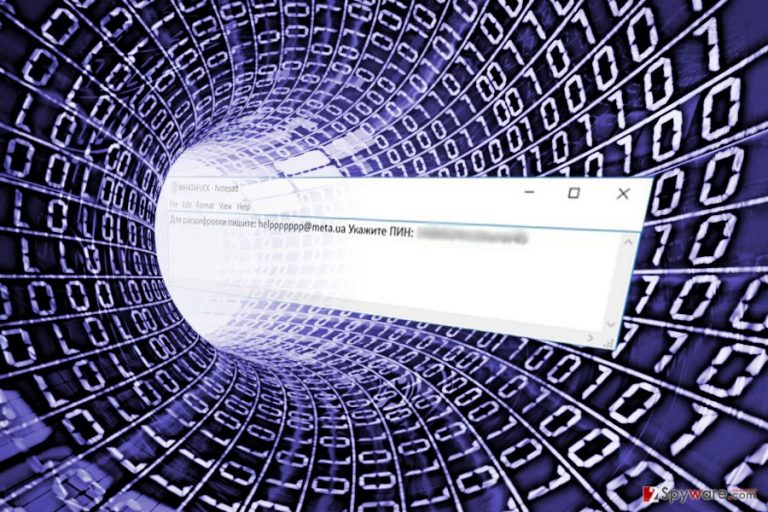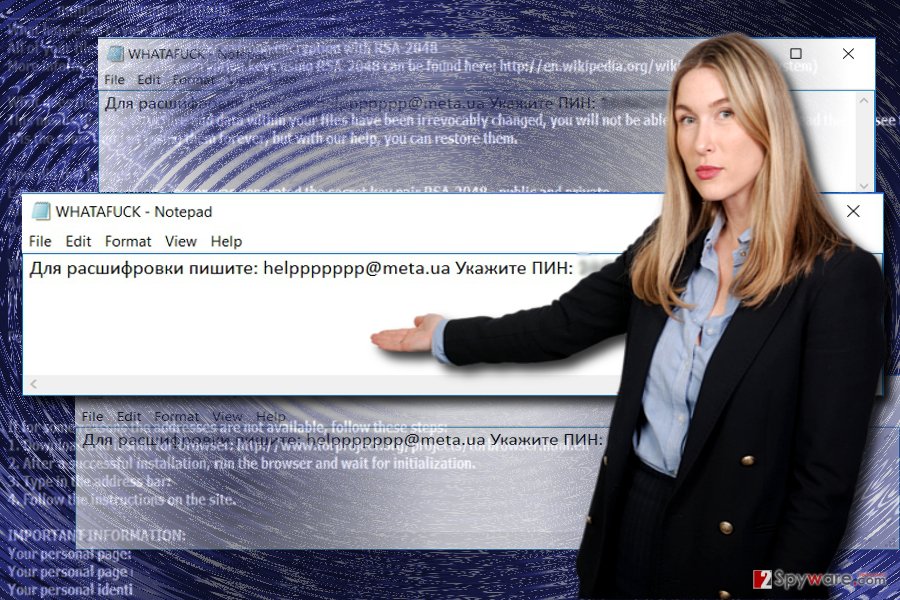Whatafuck ransomware / virus (Free Instructions) - Removal Guide
Whatafuck virus Removal Guide
What is Whatafuck ransomware virus?
Whatafuck malware hackers mock their victims again
Whatafuck virus is not the name of a joke but rather of a quite troublesome ransomware. When it corrupts PCs, the virtual threat encrypts the data and attaches distinctive file extensions – +++helppppppp@meta.ua. It does not launch its specific GUI. Instead, the virus opens its WHATAFUCK.txt file where it indicates scarce information about further steps. It only mentions email address – helppppppp@meta.ua. Victims are supposed to contact the perpetrators for further instructions. Needless to say that it is not recommended to comply with the instructions but rather choose an alternative route and remove Whatafuck virus. For that purpose, you may use FortectIntego or Malwarebytes.
Interestingly, this malware functions slightly differently than other threats. The majority of ransomware threats tend to target users via spam emails, however, in this case, the virus seems to occupy users via weak Remote Desktop Protocols. Though there are not many such threats, their number is gradually increasing.[1] Though this method is less popular than spam messages, it grants more flexibility. It does not require users ‘ intervention. While spam emails containing ransomware might be ignored or terminated without extracting the corrupted attachments, in this case, users may not suspect that they risk being infected by Whatafuck malware. Though the malware does not seem to possess quite elaborate structure, the problem is that the virus may reside on the system for quite some time. Only when users spot their files being encrypted and inaccessible, the malware comes into the surface. Within that time, it may inflict more damage or collect technical information about your computer and send it to a remote server. Therefore, time is of crucial importance when dealing with ransomware. Right when you notice the ransom note on the desktop, proceed to Whatafuck removal. 
Ways to transmit the malware
Whatafuck hijack takes place during remote desktop sessions. The key problem arises whether targetted users’ RDP protocols are well protected. In other words, it is the same as with routers or other iOT devices. If their passwords are weak and easily guessable, they are exposed malware which may corrupt the entire network. In this case, if your protocols are poorly protected, there are high chances that you similar RDP ransomware may take a liking of your system.[2] In order to lower such risk, make sure you make up elaborate passwords. In addition, updated software also lowers the risk of cyber assault.
Eliminate Whatafuck ransomware effectively
Previously mentioned tools may come in handy in performing Whatafuck removal as well. Note that anti-malware applications do not decrypt files. In order to do that you may use alternative applications. At the moment, the malware is still under investigation. If it turns out to be related to HiddenTear virus, then there are chances that it might be decrypted using universal free decrypter designed for decrypting files locked by the viruses of this family. Below you will find guidelines which instruct how to reboot the computer into Safe Mode in case you cannot remove Whatafuck from the first attempt.
Getting rid of Whatafuck virus. Follow these steps
Manual removal using Safe Mode
Important! →
Manual removal guide might be too complicated for regular computer users. It requires advanced IT knowledge to be performed correctly (if vital system files are removed or damaged, it might result in full Windows compromise), and it also might take hours to complete. Therefore, we highly advise using the automatic method provided above instead.
Step 1. Access Safe Mode with Networking
Manual malware removal should be best performed in the Safe Mode environment.
Windows 7 / Vista / XP
- Click Start > Shutdown > Restart > OK.
- When your computer becomes active, start pressing F8 button (if that does not work, try F2, F12, Del, etc. – it all depends on your motherboard model) multiple times until you see the Advanced Boot Options window.
- Select Safe Mode with Networking from the list.

Windows 10 / Windows 8
- Right-click on Start button and select Settings.

- Scroll down to pick Update & Security.

- On the left side of the window, pick Recovery.
- Now scroll down to find Advanced Startup section.
- Click Restart now.

- Select Troubleshoot.

- Go to Advanced options.

- Select Startup Settings.

- Press Restart.
- Now press 5 or click 5) Enable Safe Mode with Networking.

Step 2. Shut down suspicious processes
Windows Task Manager is a useful tool that shows all the processes running in the background. If malware is running a process, you need to shut it down:
- Press Ctrl + Shift + Esc on your keyboard to open Windows Task Manager.
- Click on More details.

- Scroll down to Background processes section, and look for anything suspicious.
- Right-click and select Open file location.

- Go back to the process, right-click and pick End Task.

- Delete the contents of the malicious folder.
Step 3. Check program Startup
- Press Ctrl + Shift + Esc on your keyboard to open Windows Task Manager.
- Go to Startup tab.
- Right-click on the suspicious program and pick Disable.

Step 4. Delete virus files
Malware-related files can be found in various places within your computer. Here are instructions that could help you find them:
- Type in Disk Cleanup in Windows search and press Enter.

- Select the drive you want to clean (C: is your main drive by default and is likely to be the one that has malicious files in).
- Scroll through the Files to delete list and select the following:
Temporary Internet Files
Downloads
Recycle Bin
Temporary files - Pick Clean up system files.

- You can also look for other malicious files hidden in the following folders (type these entries in Windows Search and press Enter):
%AppData%
%LocalAppData%
%ProgramData%
%WinDir%
After you are finished, reboot the PC in normal mode.
Remove Whatafuck using System Restore
Alternative option, System Restore, also grants you access to vital system functions.
-
Step 1: Reboot your computer to Safe Mode with Command Prompt
Windows 7 / Vista / XP- Click Start → Shutdown → Restart → OK.
- When your computer becomes active, start pressing F8 multiple times until you see the Advanced Boot Options window.
-
Select Command Prompt from the list

Windows 10 / Windows 8- Press the Power button at the Windows login screen. Now press and hold Shift, which is on your keyboard, and click Restart..
- Now select Troubleshoot → Advanced options → Startup Settings and finally press Restart.
-
Once your computer becomes active, select Enable Safe Mode with Command Prompt in Startup Settings window.

-
Step 2: Restore your system files and settings
-
Once the Command Prompt window shows up, enter cd restore and click Enter.

-
Now type rstrui.exe and press Enter again..

-
When a new window shows up, click Next and select your restore point that is prior the infiltration of Whatafuck. After doing that, click Next.


-
Now click Yes to start system restore.

-
Once the Command Prompt window shows up, enter cd restore and click Enter.
Bonus: Recover your data
Guide which is presented above is supposed to help you remove Whatafuck from your computer. To recover your encrypted files, we recommend using a detailed guide prepared by 2-spyware.com security experts.If your files are encrypted by Whatafuck, you can use several methods to restore them:
Data Recovery Pro method
Backup copies serve to be the most viable way of recovering files. However, if you hadn’t made them before the assault of Whatafuck assault, you may benefit from this program.
- Download Data Recovery Pro;
- Follow the steps of Data Recovery Setup and install the program on your computer;
- Launch it and scan your computer for files encrypted by Whatafuck ransomware;
- Restore them.
Decoding files encrypted by Whatafuck virus with ShadowExplorer
There are high chances that you this might be effective in your case since there isno information whether the ransomware deletes these copies.
- Download Shadow Explorer (http://shadowexplorer.com/);
- Follow a Shadow Explorer Setup Wizard and install this application on your computer;
- Launch the program and go through the drop down menu on the top left corner to select the disk of your encrypted data. Check what folders are there;
- Right-click on the folder you want to restore and select “Export”. You can also select where you want it to be stored.
Whatafuck Decrypter
Whatafuck decryption software is not available yet. Let us advise you not to download any decoding tools offered by the hackers. Such programs may only create more security vulnerabilities in the future.
Finally, you should always think about the protection of crypto-ransomwares. In order to protect your computer from Whatafuck and other ransomwares, use a reputable anti-spyware, such as FortectIntego, SpyHunter 5Combo Cleaner or Malwarebytes
How to prevent from getting ransomware
Access your website securely from any location
When you work on the domain, site, blog, or different project that requires constant management, content creation, or coding, you may need to connect to the server and content management service more often. The best solution for creating a tighter network could be a dedicated/fixed IP address.
If you make your IP address static and set to your device, you can connect to the CMS from any location and do not create any additional issues for the server or network manager that needs to monitor connections and activities. VPN software providers like Private Internet Access can help you with such settings and offer the option to control the online reputation and manage projects easily from any part of the world.
Recover files after data-affecting malware attacks
While much of the data can be accidentally deleted due to various reasons, malware is one of the main culprits that can cause loss of pictures, documents, videos, and other important files. More serious malware infections lead to significant data loss when your documents, system files, and images get encrypted. In particular, ransomware is is a type of malware that focuses on such functions, so your files become useless without an ability to access them.
Even though there is little to no possibility to recover after file-locking threats, some applications have features for data recovery in the system. In some cases, Data Recovery Pro can also help to recover at least some portion of your data after data-locking virus infection or general cyber infection.
- ^ Boyan Angelov. RDP Attacks Allow Hackers to Spread RSAUtil Ransomware. VirusGuides. Powered by Knowledge.
- ^ Securing Remote Desktop (RDP) for System Administrators. Berkeley Information Security and Policy.







